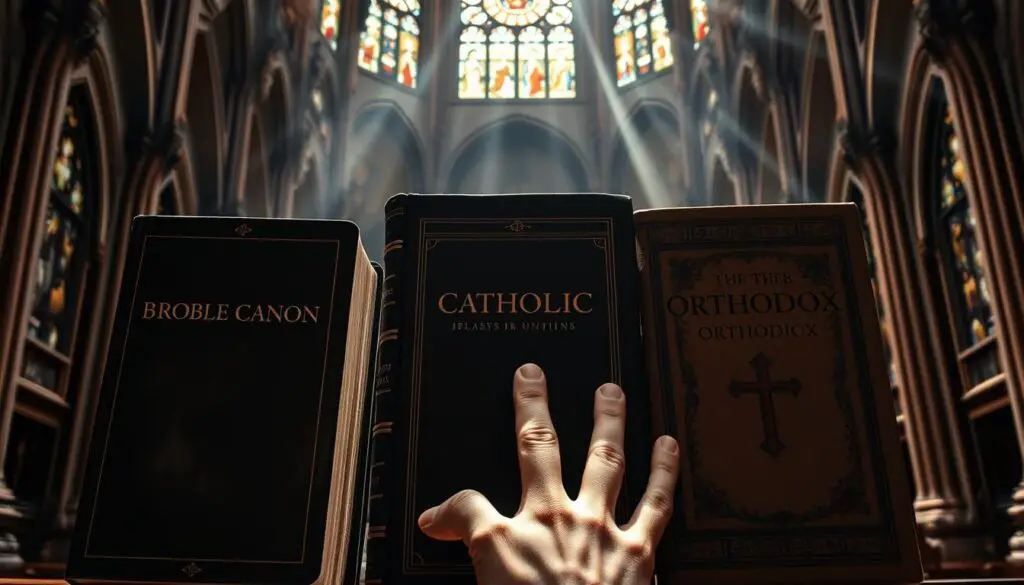Let’s dive into a foundational text that shapes millions of lives. This collection of 66 books serves as the spiritual backbone for many believers, offering guidance through stories, wisdom, and principles. Unlike other traditions, its structure prioritizes direct engagement with scripture, inviting everyone to explore its pages personally.
What makes these writings unique? They emphasize practical teachings designed to influence daily life. From parables to letters, each book connects timeless truths to modern challenges. This accessibility has fueled its role in shaping faith communities for centuries.
Modern readers often find its messages surprisingly relevant. The focus on individual interpretation encourages people to apply lessons to their own contexts. Whether seeking comfort or direction, these texts remain a go-to resource for spiritual growth.
Why does this matter today? In a fast-paced world, the emphasis on personal reflection helps believers navigate complex issues. By prioritizing scriptural literacy, communities foster deeper connections to their values—and to each other.
Key Takeaways
- The collection includes 66 distinct books, forming a streamlined scriptural foundation.
- Personal study and interpretation are central to engaging with these texts.
- Teachings emphasize real-world applications for modern challenges.
- Accessibility allows everyday people to connect with spiritual wisdom directly.
- Its structure reflects historical decisions that distinguish it from other traditions.
Historical Origins and Canonical Developments
The story behind sacred texts reveals how early believers shaped their spiritual foundations. For centuries, communities debated which writings held divine authority. This process created a dynamic historical journey still studied today.
Evolution of the Old Testament Canon
Early followers faced questions about authentic books. Without an official list from Jesus or apostles, leaders relied on Jewish traditions. Fourth-century collections like Vaticanus included extra texts now called deuterocanonical. These works circulated widely but faced later scrutiny.
| Key Documents | Included Texts | Time Period |
|---|---|---|
| Vaticanus Codex | Deuterocanon + Standard Books | 4th Century |
| Origen’s List | Hebrew Bible Alignment | 3rd Century |
| Melito’s Catalog | Excluded Additions | 2nd Century |
Early Christian Reception and the Role of the Deuterocanonical Books
By 200-300 CE, many churches treated deuterocanonical works as scripture. Leaders like Augustine quoted them, while others preferred stricter Hebrew models. Romans 3:2 influenced this debate, linking divine authority to Jewish stewardship.
This tension created lasting impacts. Some groups preserved all texts; others streamlined their canon. These choices still define differences among modern faith traditions.
Understanding the Protestant Bible in Comparison with Catholic and Orthodox Traditions
Christian groups share core spiritual texts but differ in how they define their sacred libraries. While all recognize the New Testament’s 27 books, the Old Testament becomes the key dividing line. This distinction shapes doctrinal perspectives and worship practices worldwide.

Canonical Differences and Authority in Doctrine
The Catholic Bible includes 46 Old Testament writings, while other traditions use 39. Seven extra texts—like Tobit and Maccabees—form what Catholics call the Deuterocanon. Others label them Apocrypha, meaning “hidden writings.”
These differences matter because they influence doctrine. For example, 2 Maccabees mentions praying for the dead—a practice linked to purgatory in Catholic doctrine. Reformers rejected these texts partly over such teachings.
Historical Debates and the Council of Trent’s Impact
In 1546, the Catholic Church clarified its stance at Trent. Leaders affirmed Deuterocanonical books as fully authoritative. Yet records show some viewed this as confirming existing practice rather than creating new rules.
This decision deepened existing divides. Protestant theologians argued for aligning with Hebrew scriptures, while Catholics embraced Greek translations containing extra texts. Both sides claimed authority through different historical lenses.
Today, these debates remind us how ancient choices still shape modern faith. Understanding them helps explain why certain groups emphasize specific practices or beliefs.
Key Teachings and Doctrines in the Protestant Bible
At the heart of Christian belief systems lie principles that guide how communities engage with sacred texts. These ideas shape spiritual practices and personal relationships with divine messages.
Sola Scriptura and the Doctrine of Perspicuity
One revolutionary idea transformed how people approach sacred writings. Martin Luther famously declared:
“Scripture interprets itself and tests everything else.”
This concept—called perspicuity—means essential truths aboutsalvationremain clear to all seekers.
The Westminster Confession explains it simply: While some passages challenge readers, vital teachings shine through. Ordinary study methods unlock understanding for everyone. As Luther observed, this clarity makes scripture the ultimate authority—not institutions or traditions.
Interpretations on Salvation, Justification, and Faith
Central to these teachings is the belief that justification comes through faith alone. Good works or rituals don’t earn divine favor. This perspective reshaped worship practices, prioritizing personal engagement over ceremonial routines.
Modern believers still find this doctrine empowering. It creates a direct way to connect with spiritual truths without intermediaries. Communities encourage members to explore texts personally while valuing guidance from trusted sources.
These ideas continue shaping discussions about spiritual growth. By emphasizing accessibility, they remind us that profound wisdom often arrives in simple packages.
The Role of Translation and Interpretation
Words hold power—especially when they bridge gaps between cultures and centuries. Translating sacred texts requires balancing ancient meanings with modern understanding. This delicate process shapes how communities engage with spiritual wisdom today.

Modern Protestant Bible Translations and Their Influence
Popular versions like the ESV and NIV dominate church pews for good reason. These translations blend readability with precision, letting everyday readers grasp complex ideas. The ESV sticks closely to original languages, while the NIV rephrases concepts for clarity.
Scholars spend years comparing ancient manuscripts to create these works. Their goal? To preserve core messages while using contemporary speech patterns. As one author noted:
“A good translation disappears, letting the text speak for itself.”
Historical Shifts in Interpretation Practices
Early reformers prioritized accessibility. Martin Luther’s German Bible set a precedent by using common speech instead of Latin. This way of thinking sparked a revolution—suddenly, farmers and merchants could read scripture firsthand.
Modern approaches combine linguistic analysis with archaeological finds. Teams now reference Dead Sea Scrolls and early Greek copies to refine books like the New Testament. These methods help scholars uncover layers of meaning hidden for centuries.
While debates continue about ideal translation methods, one truth remains: putting sacred texts in people’s hands changes lives. From Luther’s time to today, this mission keeps ancient wisdom alive in a changing world.
Contemporary Relevance in the United States
In American churches today, dog-eared pages in well-used copies of modern translations reveal a living tradition. These works shape worship services, small group studies, and even casual conversations about spiritual growth. Their influence extends beyond Sunday mornings into daily life, helping believers navigate modern ethical dilemmas.

Impact on Modern Faith Practices and Christian Living
Walk into any evangelical church, and you’ll likely find NIV or ESV bibles in every pew. These translations dominate because they balance accuracy with approachable language. Many churches host weekly study groups where members dissect passages together, applying lessons to workplace ethics or family dynamics.
| Popular Translation | Usage Rate | Key Feature |
|---|---|---|
| NIV | 48% | Thought-for-thought clarity |
| ESV | 32% | Word-for-word precision |
| KJV | 12% | Traditional language |
The Ongoing Debate Among Theologians and Scholars
Recent papers from Ivy League conferences show heated discussions about scriptural authority. One scholar notes:
“Our challenge lies in honoring ancient texts while addressing AI ethics and climate crises.”
These debates often circle back to Reformation-era questions. How much weight should tradition hold? Who gets to define salvation in a pluralistic society? While answers vary, the conversation itself keeps ancient texts vital in modern America.
Conclusion
The legacy of ancient scriptures remains vibrant in today’s diverse spiritual practices. At its core, the Protestant Bible reflects a 500-year journey of prioritizing direct access to sacred teachings. Its 66 books—carefully curated through centuries of debate—offer a distinct lens compared to the Catholic Church’s expanded canon.
Martin Luther’s emphasis on scriptural clarity reshaped how communities engage with truth. This approach empowered ordinary people to explore faith without relying solely on institutional authority. Differences in the Old Testament’s scope still spark discussions about doctrine and tradition.
Modern translation efforts continue this mission, balancing ancient context with relatable language. As believers navigate ethical dilemmas, these texts provide timeless wisdom for questions about salvation and daily life.
Ultimately, this collection isn’t just historical artifact—it’s a living conversation. By inviting personal exploration, it keeps ancient wisdom relevant in our ever-changing world.
FAQ
Why does the Protestant Bible exclude certain books found in Catholic and Orthodox traditions?
During the Reformation, leaders like Martin Luther emphasized returning to Hebrew manuscripts for the Old Testament, rejecting deuterocanonical texts like Tobit and Maccabees. These writings, accepted by the Council of Trent in 1546, were seen as lacking original Hebrew sources or conflicting with key doctrines like justification by faith alone.
How did the Council of Trent shape differences in biblical authority between traditions?
The Council of Trent solidified Catholic doctrine by affirming the deuterocanonical books as inspired and declaring church tradition equal to Scripture. Reformers rejected this, arguing Sola Scriptura—that Scripture alone holds ultimate authority for faith and practice, leading to lasting canonical divisions.
What does Sola Scriptura mean for interpreting teachings like salvation?
This doctrine asserts that Scripture is clear enough for believers to understand essentials like salvation through faith in Christ. It downplays reliance on institutional authority, emphasizing personal study and the Holy Spirit’s role in guiding interpretation of passages about grace and redemption.
How have modern translations influenced Protestant practices in the U.S.?
Versions like the NIV and ESV prioritize readability while balancing accuracy, making teachings accessible. They shape preaching, small-group studies, and evangelism, though debates continue about balancing literal translation with contemporary language.
Why do theologians still debate the role of tradition in biblical interpretation?
Some argue tradition provides historical context, while others fear it risks diluting Scripture’s authority. These discussions affect how churches address modern issues, from social justice to gender roles, reflecting tensions between ancient texts and evolving cultural values.